Analyzing Google: Organizational Behavior, Strategies, and Pitfalls
VerifiedAdded on 2023/06/12
|13
|3022
|307
Report
AI Summary
This report provides a comprehensive analysis of Google's organizational behavior, corporate strategies, and action plans. It begins with an introduction to Google, highlighting its mission and scope, followed by an examination of its organizational culture, emphasizing its treatment of employees and users. The report then delves into Google's corporate strategies, focusing on value creation and competitive advantage, presenting an action plan in a S.M.A.R.T. format. It also addresses the pitfalls Google faces, particularly in the global arena, and offers recommendations for maintaining its competitive edge through continuous innovation, product diversification, and talent acquisition. The report concludes by emphasizing Google's position as a leading force in the digital information era.
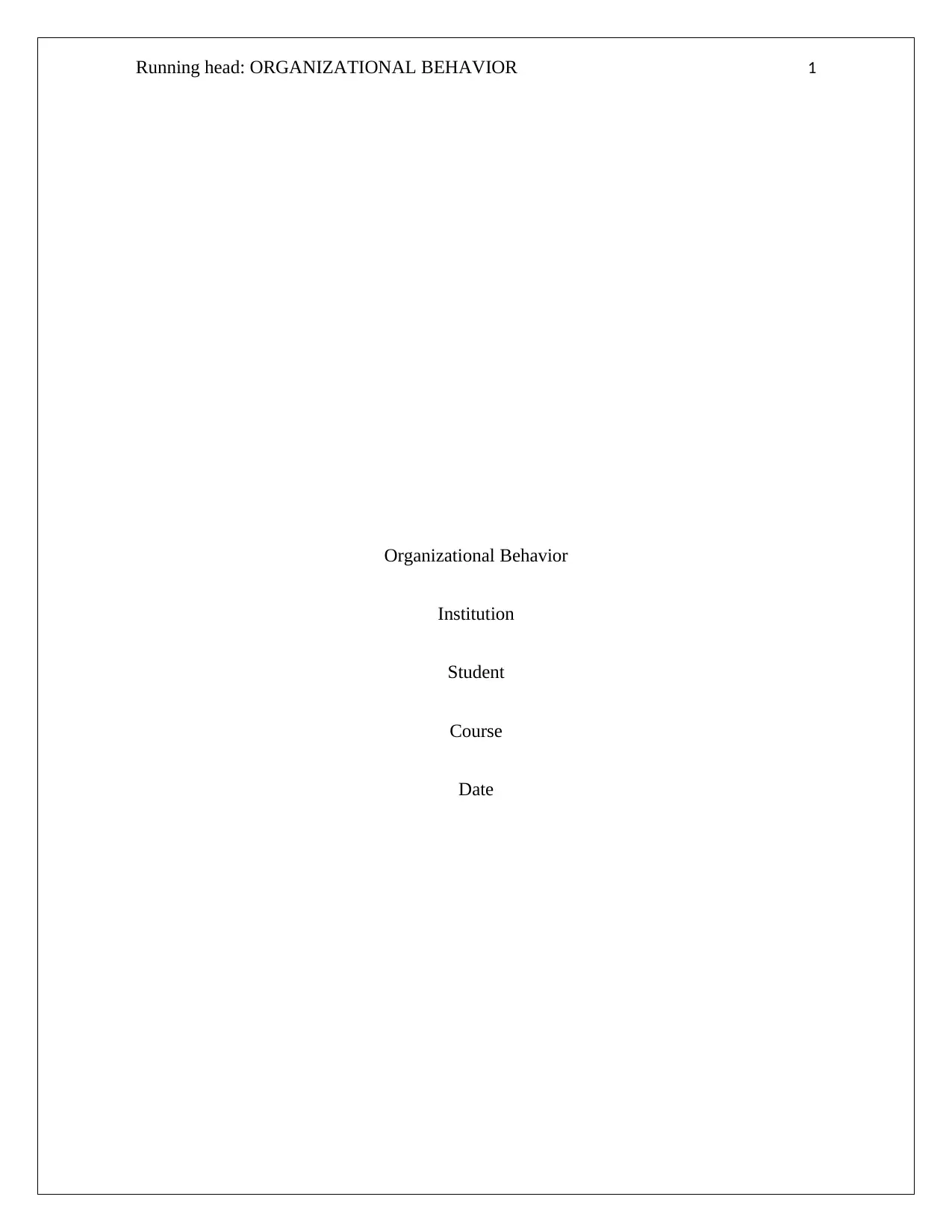
Running head: ORGANIZATIONAL BEHAVIOR 1
Organizational Behavior
Institution
Student
Course
Date
Organizational Behavior
Institution
Student
Course
Date
Paraphrase This Document
Need a fresh take? Get an instant paraphrase of this document with our AI Paraphraser
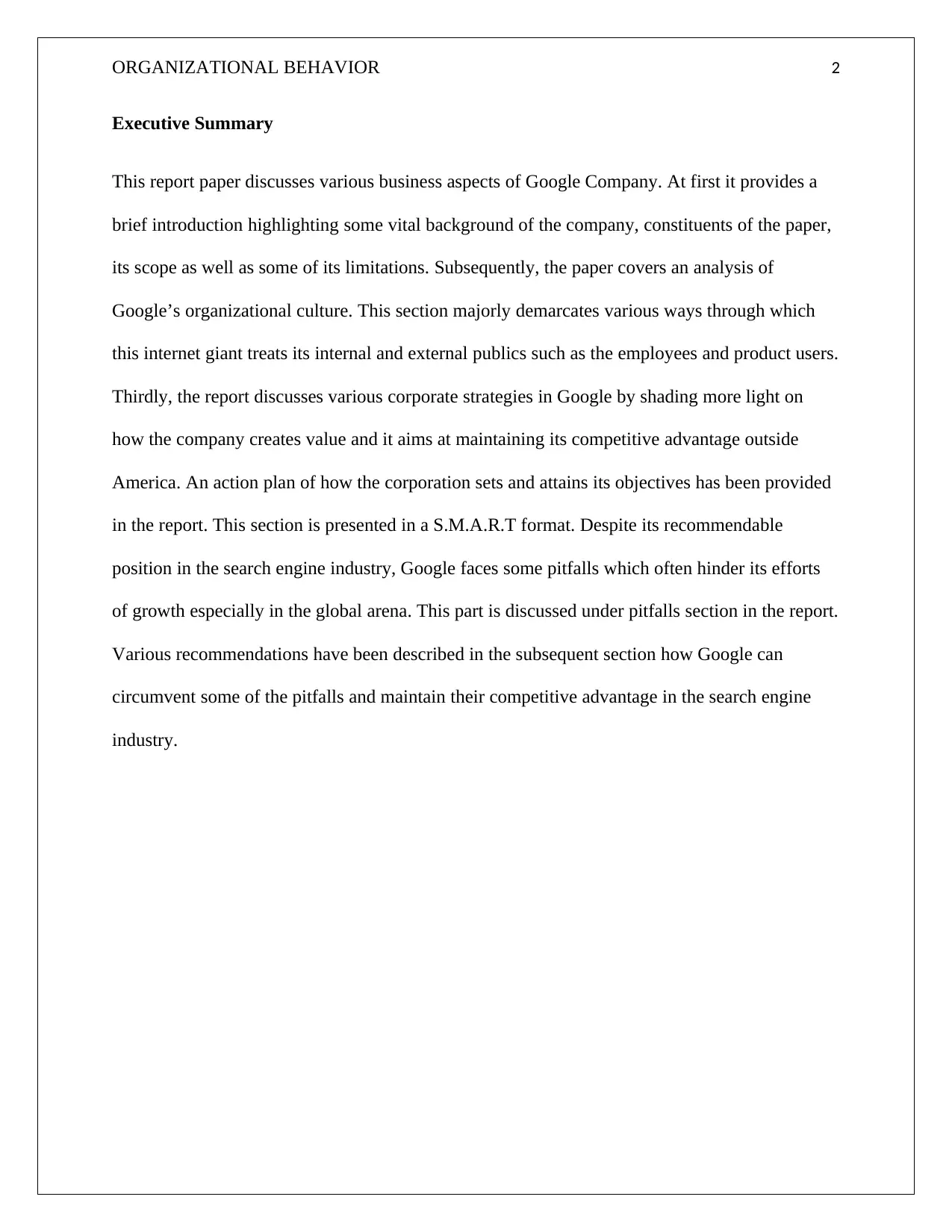
ORGANIZATIONAL BEHAVIOR 2
Executive Summary
This report paper discusses various business aspects of Google Company. At first it provides a
brief introduction highlighting some vital background of the company, constituents of the paper,
its scope as well as some of its limitations. Subsequently, the paper covers an analysis of
Google’s organizational culture. This section majorly demarcates various ways through which
this internet giant treats its internal and external publics such as the employees and product users.
Thirdly, the report discusses various corporate strategies in Google by shading more light on
how the company creates value and it aims at maintaining its competitive advantage outside
America. An action plan of how the corporation sets and attains its objectives has been provided
in the report. This section is presented in a S.M.A.R.T format. Despite its recommendable
position in the search engine industry, Google faces some pitfalls which often hinder its efforts
of growth especially in the global arena. This part is discussed under pitfalls section in the report.
Various recommendations have been described in the subsequent section how Google can
circumvent some of the pitfalls and maintain their competitive advantage in the search engine
industry.
Executive Summary
This report paper discusses various business aspects of Google Company. At first it provides a
brief introduction highlighting some vital background of the company, constituents of the paper,
its scope as well as some of its limitations. Subsequently, the paper covers an analysis of
Google’s organizational culture. This section majorly demarcates various ways through which
this internet giant treats its internal and external publics such as the employees and product users.
Thirdly, the report discusses various corporate strategies in Google by shading more light on
how the company creates value and it aims at maintaining its competitive advantage outside
America. An action plan of how the corporation sets and attains its objectives has been provided
in the report. This section is presented in a S.M.A.R.T format. Despite its recommendable
position in the search engine industry, Google faces some pitfalls which often hinder its efforts
of growth especially in the global arena. This part is discussed under pitfalls section in the report.
Various recommendations have been described in the subsequent section how Google can
circumvent some of the pitfalls and maintain their competitive advantage in the search engine
industry.
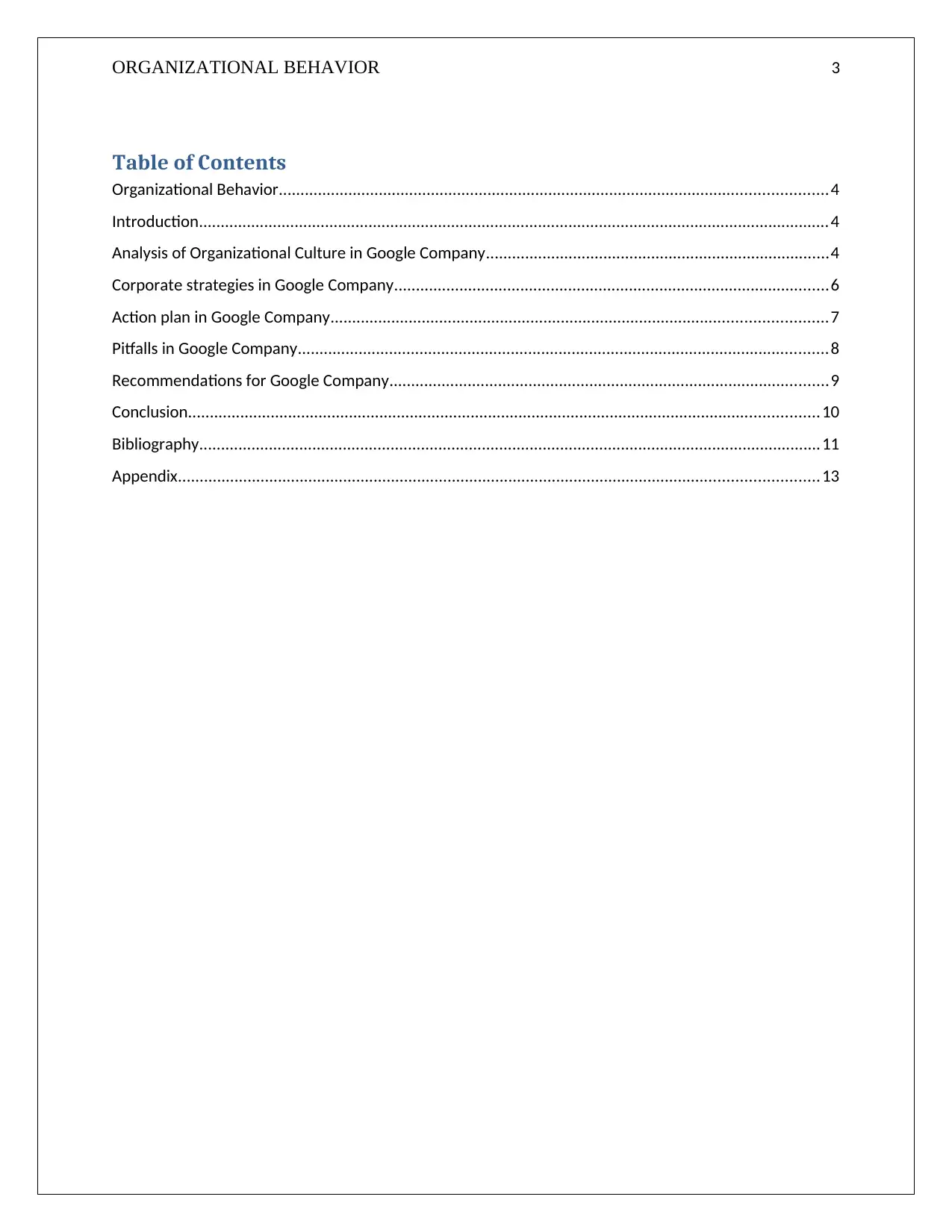
ORGANIZATIONAL BEHAVIOR 3
Table of Contents
Organizational Behavior..............................................................................................................................4
Introduction.................................................................................................................................................4
Analysis of Organizational Culture in Google Company...............................................................................4
Corporate strategies in Google Company....................................................................................................6
Action plan in Google Company..................................................................................................................7
Pitfalls in Google Company..........................................................................................................................8
Recommendations for Google Company.....................................................................................................9
Conclusion.................................................................................................................................................10
Bibliography...............................................................................................................................................11
Appendix...................................................................................................................................................13
Table of Contents
Organizational Behavior..............................................................................................................................4
Introduction.................................................................................................................................................4
Analysis of Organizational Culture in Google Company...............................................................................4
Corporate strategies in Google Company....................................................................................................6
Action plan in Google Company..................................................................................................................7
Pitfalls in Google Company..........................................................................................................................8
Recommendations for Google Company.....................................................................................................9
Conclusion.................................................................................................................................................10
Bibliography...............................................................................................................................................11
Appendix...................................................................................................................................................13
⊘ This is a preview!⊘
Do you want full access?
Subscribe today to unlock all pages.

Trusted by 1+ million students worldwide
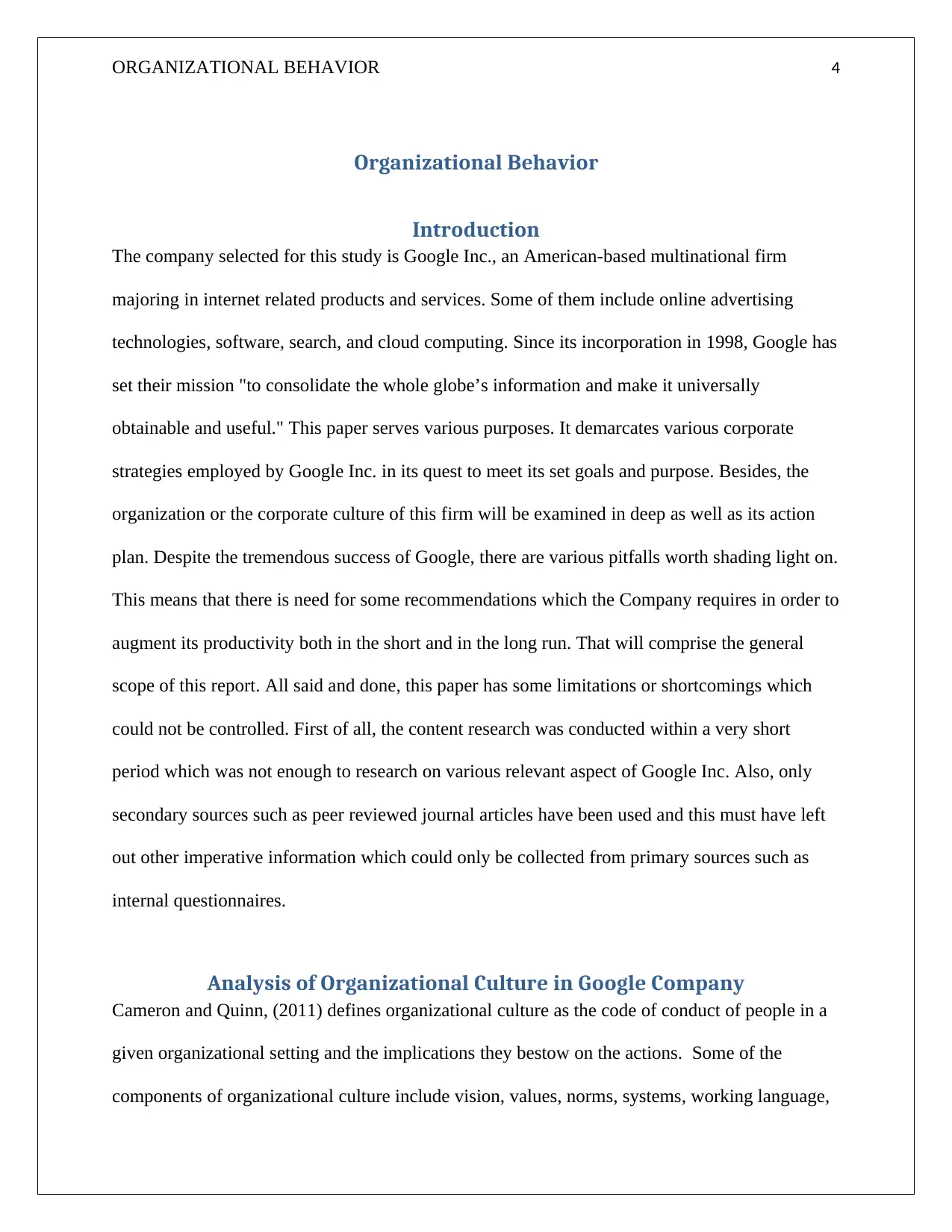
ORGANIZATIONAL BEHAVIOR 4
Organizational Behavior
Introduction
The company selected for this study is Google Inc., an American-based multinational firm
majoring in internet related products and services. Some of them include online advertising
technologies, software, search, and cloud computing. Since its incorporation in 1998, Google has
set their mission "to consolidate the whole globe’s information and make it universally
obtainable and useful." This paper serves various purposes. It demarcates various corporate
strategies employed by Google Inc. in its quest to meet its set goals and purpose. Besides, the
organization or the corporate culture of this firm will be examined in deep as well as its action
plan. Despite the tremendous success of Google, there are various pitfalls worth shading light on.
This means that there is need for some recommendations which the Company requires in order to
augment its productivity both in the short and in the long run. That will comprise the general
scope of this report. All said and done, this paper has some limitations or shortcomings which
could not be controlled. First of all, the content research was conducted within a very short
period which was not enough to research on various relevant aspect of Google Inc. Also, only
secondary sources such as peer reviewed journal articles have been used and this must have left
out other imperative information which could only be collected from primary sources such as
internal questionnaires.
Analysis of Organizational Culture in Google Company
Cameron and Quinn, (2011) defines organizational culture as the code of conduct of people in a
given organizational setting and the implications they bestow on the actions. Some of the
components of organizational culture include vision, values, norms, systems, working language,
Organizational Behavior
Introduction
The company selected for this study is Google Inc., an American-based multinational firm
majoring in internet related products and services. Some of them include online advertising
technologies, software, search, and cloud computing. Since its incorporation in 1998, Google has
set their mission "to consolidate the whole globe’s information and make it universally
obtainable and useful." This paper serves various purposes. It demarcates various corporate
strategies employed by Google Inc. in its quest to meet its set goals and purpose. Besides, the
organization or the corporate culture of this firm will be examined in deep as well as its action
plan. Despite the tremendous success of Google, there are various pitfalls worth shading light on.
This means that there is need for some recommendations which the Company requires in order to
augment its productivity both in the short and in the long run. That will comprise the general
scope of this report. All said and done, this paper has some limitations or shortcomings which
could not be controlled. First of all, the content research was conducted within a very short
period which was not enough to research on various relevant aspect of Google Inc. Also, only
secondary sources such as peer reviewed journal articles have been used and this must have left
out other imperative information which could only be collected from primary sources such as
internal questionnaires.
Analysis of Organizational Culture in Google Company
Cameron and Quinn, (2011) defines organizational culture as the code of conduct of people in a
given organizational setting and the implications they bestow on the actions. Some of the
components of organizational culture include vision, values, norms, systems, working language,
Paraphrase This Document
Need a fresh take? Get an instant paraphrase of this document with our AI Paraphraser
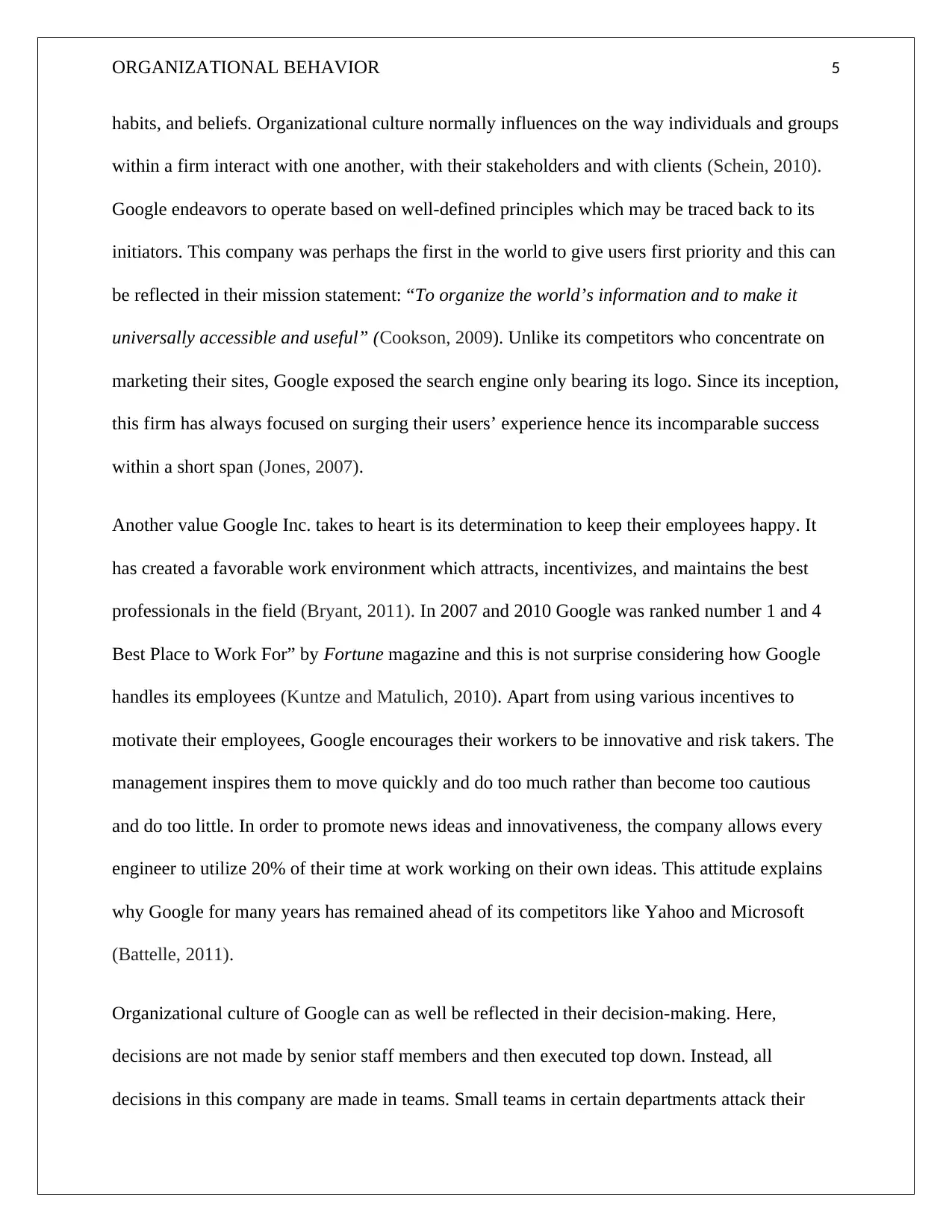
ORGANIZATIONAL BEHAVIOR 5
habits, and beliefs. Organizational culture normally influences on the way individuals and groups
within a firm interact with one another, with their stakeholders and with clients (Schein, 2010).
Google endeavors to operate based on well-defined principles which may be traced back to its
initiators. This company was perhaps the first in the world to give users first priority and this can
be reflected in their mission statement: “To organize the world’s information and to make it
universally accessible and useful” (Cookson, 2009). Unlike its competitors who concentrate on
marketing their sites, Google exposed the search engine only bearing its logo. Since its inception,
this firm has always focused on surging their users’ experience hence its incomparable success
within a short span (Jones, 2007).
Another value Google Inc. takes to heart is its determination to keep their employees happy. It
has created a favorable work environment which attracts, incentivizes, and maintains the best
professionals in the field (Bryant, 2011). In 2007 and 2010 Google was ranked number 1 and 4
Best Place to Work For” by Fortune magazine and this is not surprise considering how Google
handles its employees (Kuntze and Matulich, 2010). Apart from using various incentives to
motivate their employees, Google encourages their workers to be innovative and risk takers. The
management inspires them to move quickly and do too much rather than become too cautious
and do too little. In order to promote news ideas and innovativeness, the company allows every
engineer to utilize 20% of their time at work working on their own ideas. This attitude explains
why Google for many years has remained ahead of its competitors like Yahoo and Microsoft
(Battelle, 2011).
Organizational culture of Google can as well be reflected in their decision-making. Here,
decisions are not made by senior staff members and then executed top down. Instead, all
decisions in this company are made in teams. Small teams in certain departments attack their
habits, and beliefs. Organizational culture normally influences on the way individuals and groups
within a firm interact with one another, with their stakeholders and with clients (Schein, 2010).
Google endeavors to operate based on well-defined principles which may be traced back to its
initiators. This company was perhaps the first in the world to give users first priority and this can
be reflected in their mission statement: “To organize the world’s information and to make it
universally accessible and useful” (Cookson, 2009). Unlike its competitors who concentrate on
marketing their sites, Google exposed the search engine only bearing its logo. Since its inception,
this firm has always focused on surging their users’ experience hence its incomparable success
within a short span (Jones, 2007).
Another value Google Inc. takes to heart is its determination to keep their employees happy. It
has created a favorable work environment which attracts, incentivizes, and maintains the best
professionals in the field (Bryant, 2011). In 2007 and 2010 Google was ranked number 1 and 4
Best Place to Work For” by Fortune magazine and this is not surprise considering how Google
handles its employees (Kuntze and Matulich, 2010). Apart from using various incentives to
motivate their employees, Google encourages their workers to be innovative and risk takers. The
management inspires them to move quickly and do too much rather than become too cautious
and do too little. In order to promote news ideas and innovativeness, the company allows every
engineer to utilize 20% of their time at work working on their own ideas. This attitude explains
why Google for many years has remained ahead of its competitors like Yahoo and Microsoft
(Battelle, 2011).
Organizational culture of Google can as well be reflected in their decision-making. Here,
decisions are not made by senior staff members and then executed top down. Instead, all
decisions in this company are made in teams. Small teams in certain departments attack their
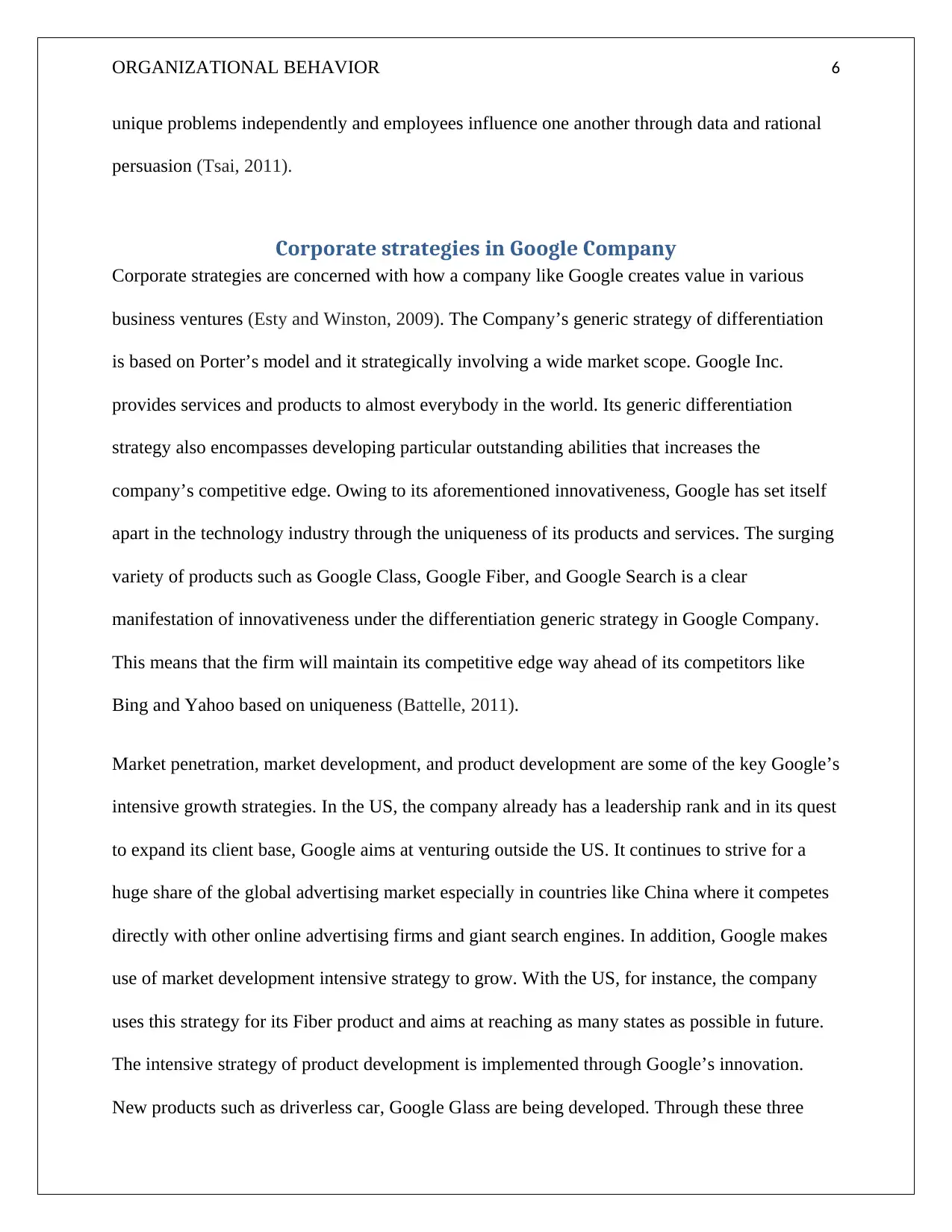
ORGANIZATIONAL BEHAVIOR 6
unique problems independently and employees influence one another through data and rational
persuasion (Tsai, 2011).
Corporate strategies in Google Company
Corporate strategies are concerned with how a company like Google creates value in various
business ventures (Esty and Winston, 2009). The Company’s generic strategy of differentiation
is based on Porter’s model and it strategically involving a wide market scope. Google Inc.
provides services and products to almost everybody in the world. Its generic differentiation
strategy also encompasses developing particular outstanding abilities that increases the
company’s competitive edge. Owing to its aforementioned innovativeness, Google has set itself
apart in the technology industry through the uniqueness of its products and services. The surging
variety of products such as Google Class, Google Fiber, and Google Search is a clear
manifestation of innovativeness under the differentiation generic strategy in Google Company.
This means that the firm will maintain its competitive edge way ahead of its competitors like
Bing and Yahoo based on uniqueness (Battelle, 2011).
Market penetration, market development, and product development are some of the key Google’s
intensive growth strategies. In the US, the company already has a leadership rank and in its quest
to expand its client base, Google aims at venturing outside the US. It continues to strive for a
huge share of the global advertising market especially in countries like China where it competes
directly with other online advertising firms and giant search engines. In addition, Google makes
use of market development intensive strategy to grow. With the US, for instance, the company
uses this strategy for its Fiber product and aims at reaching as many states as possible in future.
The intensive strategy of product development is implemented through Google’s innovation.
New products such as driverless car, Google Glass are being developed. Through these three
unique problems independently and employees influence one another through data and rational
persuasion (Tsai, 2011).
Corporate strategies in Google Company
Corporate strategies are concerned with how a company like Google creates value in various
business ventures (Esty and Winston, 2009). The Company’s generic strategy of differentiation
is based on Porter’s model and it strategically involving a wide market scope. Google Inc.
provides services and products to almost everybody in the world. Its generic differentiation
strategy also encompasses developing particular outstanding abilities that increases the
company’s competitive edge. Owing to its aforementioned innovativeness, Google has set itself
apart in the technology industry through the uniqueness of its products and services. The surging
variety of products such as Google Class, Google Fiber, and Google Search is a clear
manifestation of innovativeness under the differentiation generic strategy in Google Company.
This means that the firm will maintain its competitive edge way ahead of its competitors like
Bing and Yahoo based on uniqueness (Battelle, 2011).
Market penetration, market development, and product development are some of the key Google’s
intensive growth strategies. In the US, the company already has a leadership rank and in its quest
to expand its client base, Google aims at venturing outside the US. It continues to strive for a
huge share of the global advertising market especially in countries like China where it competes
directly with other online advertising firms and giant search engines. In addition, Google makes
use of market development intensive strategy to grow. With the US, for instance, the company
uses this strategy for its Fiber product and aims at reaching as many states as possible in future.
The intensive strategy of product development is implemented through Google’s innovation.
New products such as driverless car, Google Glass are being developed. Through these three
⊘ This is a preview!⊘
Do you want full access?
Subscribe today to unlock all pages.

Trusted by 1+ million students worldwide
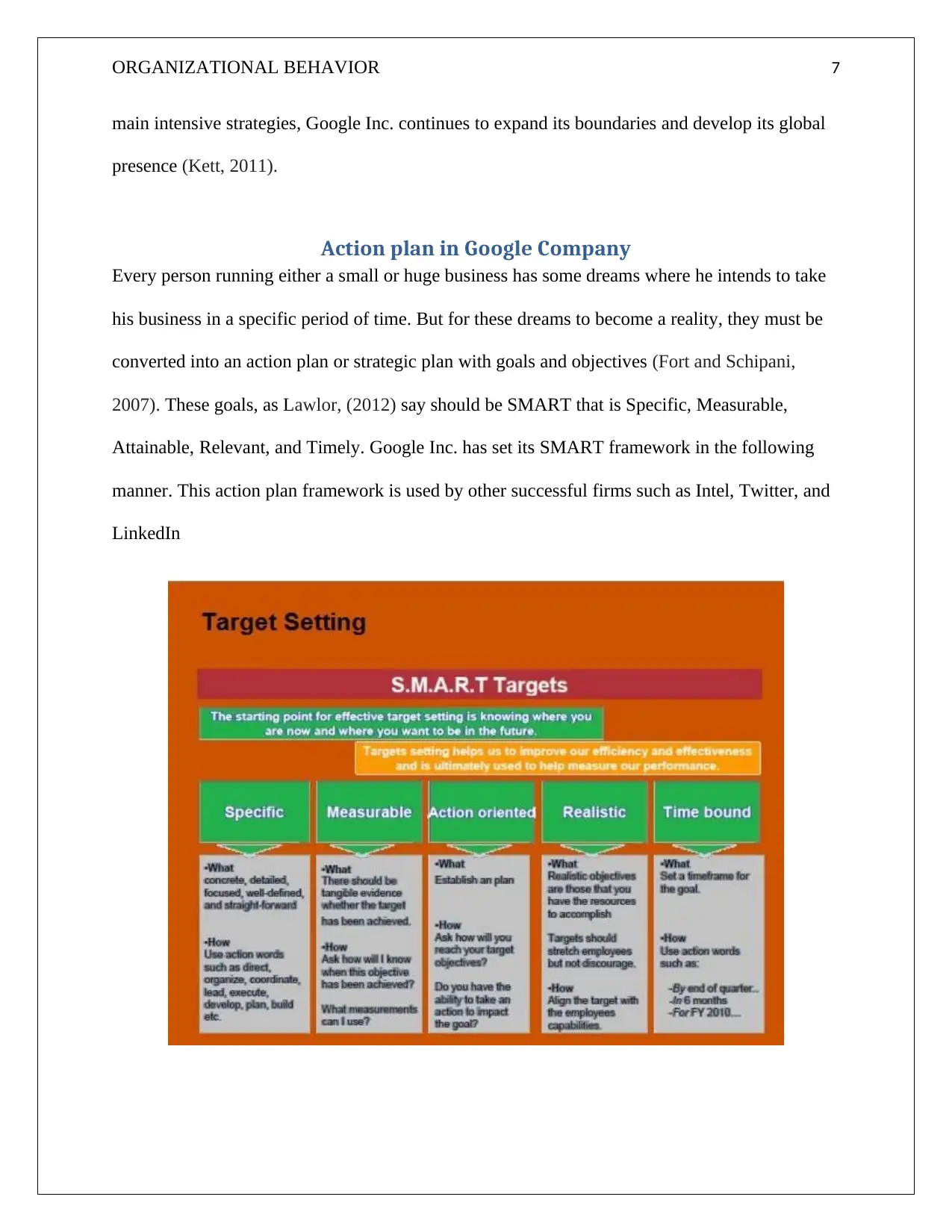
ORGANIZATIONAL BEHAVIOR 7
main intensive strategies, Google Inc. continues to expand its boundaries and develop its global
presence (Kett, 2011).
Action plan in Google Company
Every person running either a small or huge business has some dreams where he intends to take
his business in a specific period of time. But for these dreams to become a reality, they must be
converted into an action plan or strategic plan with goals and objectives (Fort and Schipani,
2007). These goals, as Lawlor, (2012) say should be SMART that is Specific, Measurable,
Attainable, Relevant, and Timely. Google Inc. has set its SMART framework in the following
manner. This action plan framework is used by other successful firms such as Intel, Twitter, and
LinkedIn
main intensive strategies, Google Inc. continues to expand its boundaries and develop its global
presence (Kett, 2011).
Action plan in Google Company
Every person running either a small or huge business has some dreams where he intends to take
his business in a specific period of time. But for these dreams to become a reality, they must be
converted into an action plan or strategic plan with goals and objectives (Fort and Schipani,
2007). These goals, as Lawlor, (2012) say should be SMART that is Specific, Measurable,
Attainable, Relevant, and Timely. Google Inc. has set its SMART framework in the following
manner. This action plan framework is used by other successful firms such as Intel, Twitter, and
Paraphrase This Document
Need a fresh take? Get an instant paraphrase of this document with our AI Paraphraser
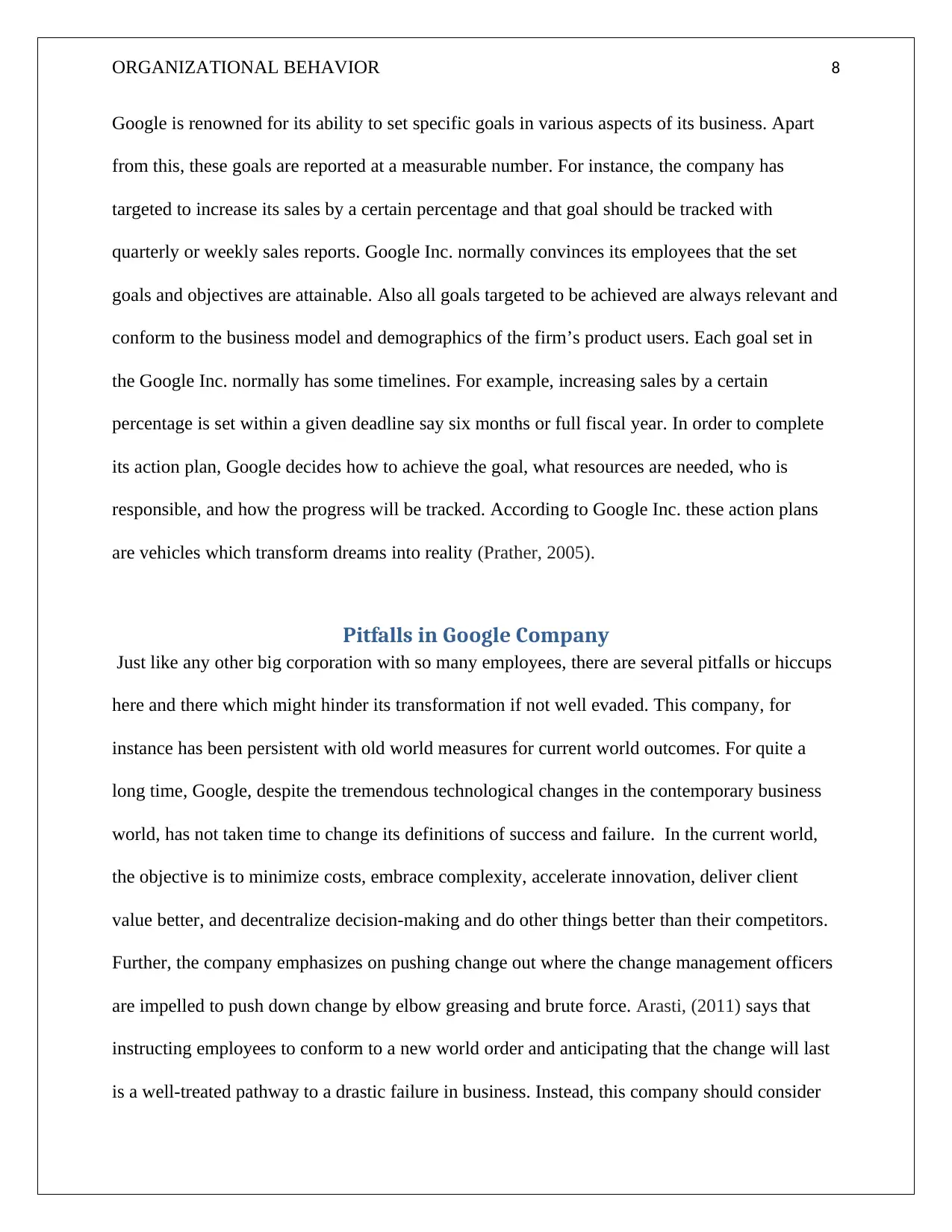
ORGANIZATIONAL BEHAVIOR 8
Google is renowned for its ability to set specific goals in various aspects of its business. Apart
from this, these goals are reported at a measurable number. For instance, the company has
targeted to increase its sales by a certain percentage and that goal should be tracked with
quarterly or weekly sales reports. Google Inc. normally convinces its employees that the set
goals and objectives are attainable. Also all goals targeted to be achieved are always relevant and
conform to the business model and demographics of the firm’s product users. Each goal set in
the Google Inc. normally has some timelines. For example, increasing sales by a certain
percentage is set within a given deadline say six months or full fiscal year. In order to complete
its action plan, Google decides how to achieve the goal, what resources are needed, who is
responsible, and how the progress will be tracked. According to Google Inc. these action plans
are vehicles which transform dreams into reality (Prather, 2005).
Pitfalls in Google Company
Just like any other big corporation with so many employees, there are several pitfalls or hiccups
here and there which might hinder its transformation if not well evaded. This company, for
instance has been persistent with old world measures for current world outcomes. For quite a
long time, Google, despite the tremendous technological changes in the contemporary business
world, has not taken time to change its definitions of success and failure. In the current world,
the objective is to minimize costs, embrace complexity, accelerate innovation, deliver client
value better, and decentralize decision-making and do other things better than their competitors.
Further, the company emphasizes on pushing change out where the change management officers
are impelled to push down change by elbow greasing and brute force. Arasti, (2011) says that
instructing employees to conform to a new world order and anticipating that the change will last
is a well-treated pathway to a drastic failure in business. Instead, this company should consider
Google is renowned for its ability to set specific goals in various aspects of its business. Apart
from this, these goals are reported at a measurable number. For instance, the company has
targeted to increase its sales by a certain percentage and that goal should be tracked with
quarterly or weekly sales reports. Google Inc. normally convinces its employees that the set
goals and objectives are attainable. Also all goals targeted to be achieved are always relevant and
conform to the business model and demographics of the firm’s product users. Each goal set in
the Google Inc. normally has some timelines. For example, increasing sales by a certain
percentage is set within a given deadline say six months or full fiscal year. In order to complete
its action plan, Google decides how to achieve the goal, what resources are needed, who is
responsible, and how the progress will be tracked. According to Google Inc. these action plans
are vehicles which transform dreams into reality (Prather, 2005).
Pitfalls in Google Company
Just like any other big corporation with so many employees, there are several pitfalls or hiccups
here and there which might hinder its transformation if not well evaded. This company, for
instance has been persistent with old world measures for current world outcomes. For quite a
long time, Google, despite the tremendous technological changes in the contemporary business
world, has not taken time to change its definitions of success and failure. In the current world,
the objective is to minimize costs, embrace complexity, accelerate innovation, deliver client
value better, and decentralize decision-making and do other things better than their competitors.
Further, the company emphasizes on pushing change out where the change management officers
are impelled to push down change by elbow greasing and brute force. Arasti, (2011) says that
instructing employees to conform to a new world order and anticipating that the change will last
is a well-treated pathway to a drastic failure in business. Instead, this company should consider
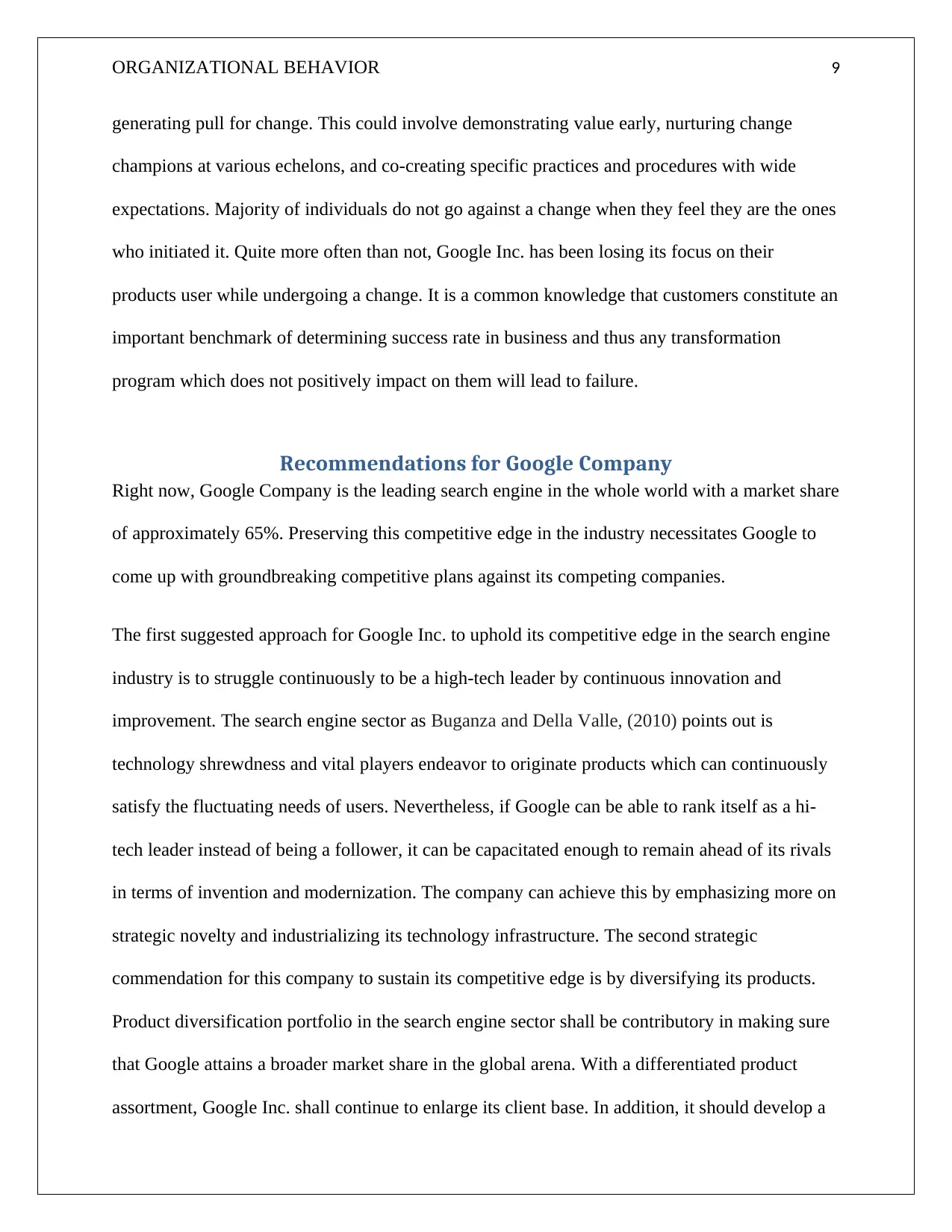
ORGANIZATIONAL BEHAVIOR 9
generating pull for change. This could involve demonstrating value early, nurturing change
champions at various echelons, and co-creating specific practices and procedures with wide
expectations. Majority of individuals do not go against a change when they feel they are the ones
who initiated it. Quite more often than not, Google Inc. has been losing its focus on their
products user while undergoing a change. It is a common knowledge that customers constitute an
important benchmark of determining success rate in business and thus any transformation
program which does not positively impact on them will lead to failure.
Recommendations for Google Company
Right now, Google Company is the leading search engine in the whole world with a market share
of approximately 65%. Preserving this competitive edge in the industry necessitates Google to
come up with groundbreaking competitive plans against its competing companies.
The first suggested approach for Google Inc. to uphold its competitive edge in the search engine
industry is to struggle continuously to be a high-tech leader by continuous innovation and
improvement. The search engine sector as Buganza and Della Valle, (2010) points out is
technology shrewdness and vital players endeavor to originate products which can continuously
satisfy the fluctuating needs of users. Nevertheless, if Google can be able to rank itself as a hi-
tech leader instead of being a follower, it can be capacitated enough to remain ahead of its rivals
in terms of invention and modernization. The company can achieve this by emphasizing more on
strategic novelty and industrializing its technology infrastructure. The second strategic
commendation for this company to sustain its competitive edge is by diversifying its products.
Product diversification portfolio in the search engine sector shall be contributory in making sure
that Google attains a broader market share in the global arena. With a differentiated product
assortment, Google Inc. shall continue to enlarge its client base. In addition, it should develop a
generating pull for change. This could involve demonstrating value early, nurturing change
champions at various echelons, and co-creating specific practices and procedures with wide
expectations. Majority of individuals do not go against a change when they feel they are the ones
who initiated it. Quite more often than not, Google Inc. has been losing its focus on their
products user while undergoing a change. It is a common knowledge that customers constitute an
important benchmark of determining success rate in business and thus any transformation
program which does not positively impact on them will lead to failure.
Recommendations for Google Company
Right now, Google Company is the leading search engine in the whole world with a market share
of approximately 65%. Preserving this competitive edge in the industry necessitates Google to
come up with groundbreaking competitive plans against its competing companies.
The first suggested approach for Google Inc. to uphold its competitive edge in the search engine
industry is to struggle continuously to be a high-tech leader by continuous innovation and
improvement. The search engine sector as Buganza and Della Valle, (2010) points out is
technology shrewdness and vital players endeavor to originate products which can continuously
satisfy the fluctuating needs of users. Nevertheless, if Google can be able to rank itself as a hi-
tech leader instead of being a follower, it can be capacitated enough to remain ahead of its rivals
in terms of invention and modernization. The company can achieve this by emphasizing more on
strategic novelty and industrializing its technology infrastructure. The second strategic
commendation for this company to sustain its competitive edge is by diversifying its products.
Product diversification portfolio in the search engine sector shall be contributory in making sure
that Google attains a broader market share in the global arena. With a differentiated product
assortment, Google Inc. shall continue to enlarge its client base. In addition, it should develop a
⊘ This is a preview!⊘
Do you want full access?
Subscribe today to unlock all pages.

Trusted by 1+ million students worldwide
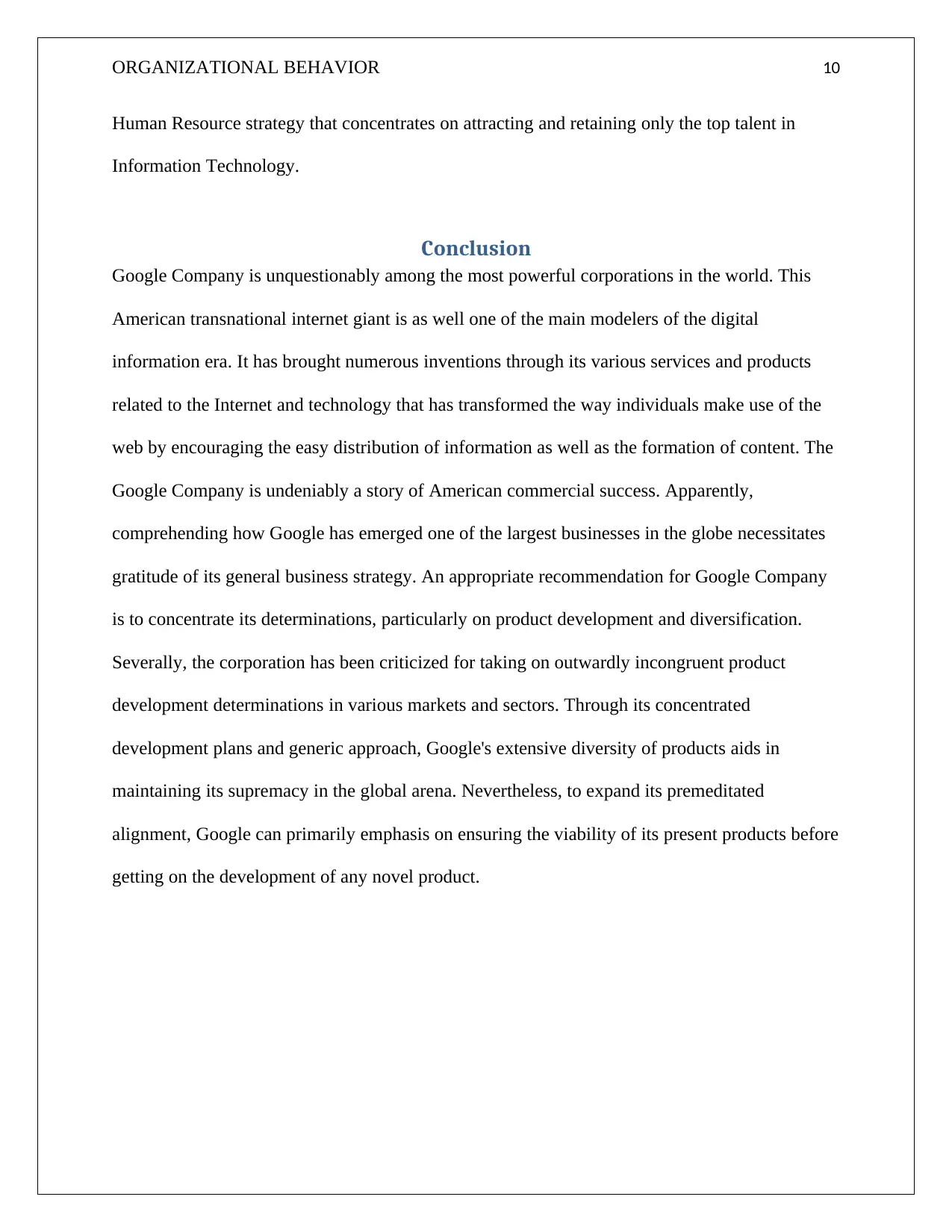
ORGANIZATIONAL BEHAVIOR 10
Human Resource strategy that concentrates on attracting and retaining only the top talent in
Information Technology.
Conclusion
Google Company is unquestionably among the most powerful corporations in the world. This
American transnational internet giant is as well one of the main modelers of the digital
information era. It has brought numerous inventions through its various services and products
related to the Internet and technology that has transformed the way individuals make use of the
web by encouraging the easy distribution of information as well as the formation of content. The
Google Company is undeniably a story of American commercial success. Apparently,
comprehending how Google has emerged one of the largest businesses in the globe necessitates
gratitude of its general business strategy. An appropriate recommendation for Google Company
is to concentrate its determinations, particularly on product development and diversification.
Severally, the corporation has been criticized for taking on outwardly incongruent product
development determinations in various markets and sectors. Through its concentrated
development plans and generic approach, Google's extensive diversity of products aids in
maintaining its supremacy in the global arena. Nevertheless, to expand its premeditated
alignment, Google can primarily emphasis on ensuring the viability of its present products before
getting on the development of any novel product.
Human Resource strategy that concentrates on attracting and retaining only the top talent in
Information Technology.
Conclusion
Google Company is unquestionably among the most powerful corporations in the world. This
American transnational internet giant is as well one of the main modelers of the digital
information era. It has brought numerous inventions through its various services and products
related to the Internet and technology that has transformed the way individuals make use of the
web by encouraging the easy distribution of information as well as the formation of content. The
Google Company is undeniably a story of American commercial success. Apparently,
comprehending how Google has emerged one of the largest businesses in the globe necessitates
gratitude of its general business strategy. An appropriate recommendation for Google Company
is to concentrate its determinations, particularly on product development and diversification.
Severally, the corporation has been criticized for taking on outwardly incongruent product
development determinations in various markets and sectors. Through its concentrated
development plans and generic approach, Google's extensive diversity of products aids in
maintaining its supremacy in the global arena. Nevertheless, to expand its premeditated
alignment, Google can primarily emphasis on ensuring the viability of its present products before
getting on the development of any novel product.
Paraphrase This Document
Need a fresh take? Get an instant paraphrase of this document with our AI Paraphraser
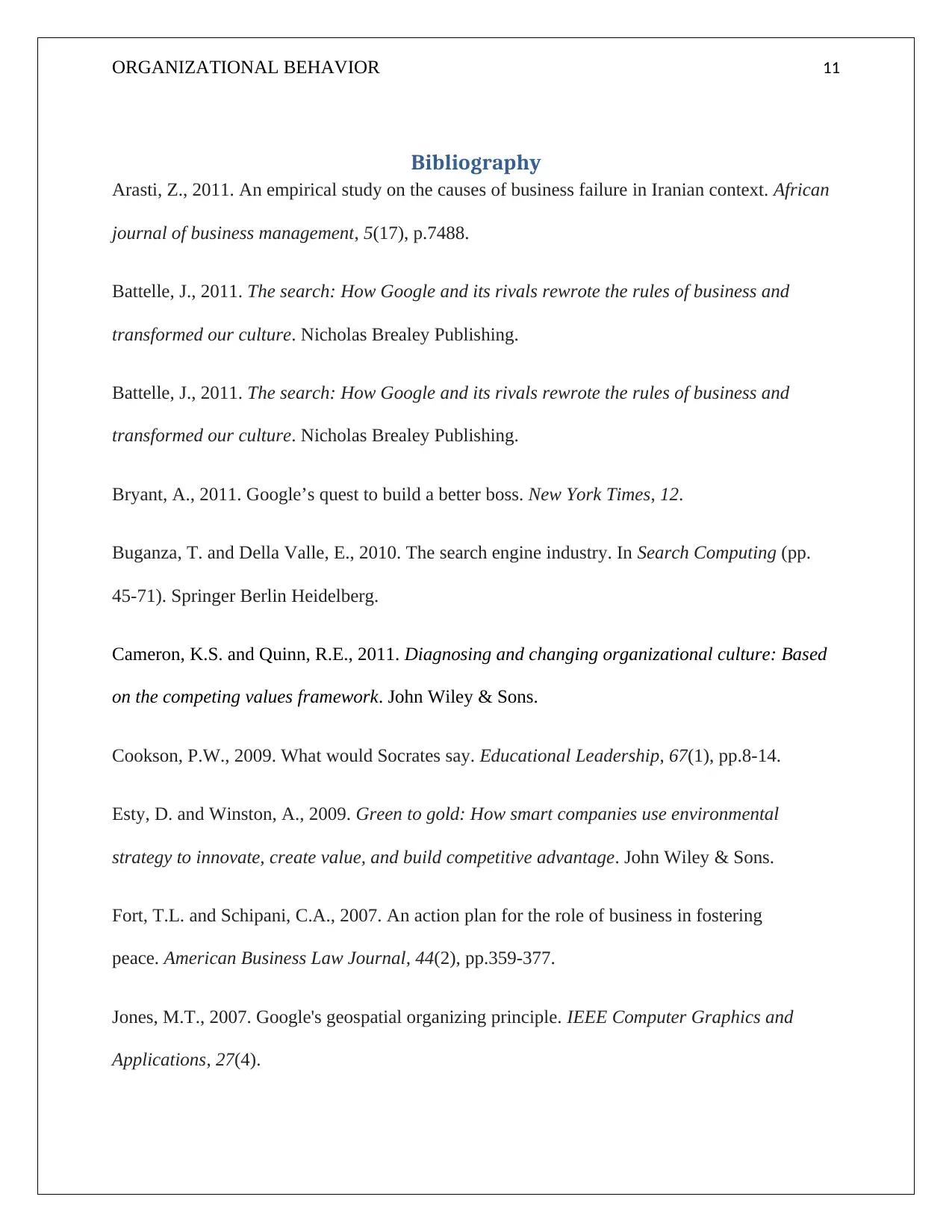
ORGANIZATIONAL BEHAVIOR 11
Bibliography
Arasti, Z., 2011. An empirical study on the causes of business failure in Iranian context. African
journal of business management, 5(17), p.7488.
Battelle, J., 2011. The search: How Google and its rivals rewrote the rules of business and
transformed our culture. Nicholas Brealey Publishing.
Battelle, J., 2011. The search: How Google and its rivals rewrote the rules of business and
transformed our culture. Nicholas Brealey Publishing.
Bryant, A., 2011. Google’s quest to build a better boss. New York Times, 12.
Buganza, T. and Della Valle, E., 2010. The search engine industry. In Search Computing (pp.
45-71). Springer Berlin Heidelberg.
Cameron, K.S. and Quinn, R.E., 2011. Diagnosing and changing organizational culture: Based
on the competing values framework. John Wiley & Sons.
Cookson, P.W., 2009. What would Socrates say. Educational Leadership, 67(1), pp.8-14.
Esty, D. and Winston, A., 2009. Green to gold: How smart companies use environmental
strategy to innovate, create value, and build competitive advantage. John Wiley & Sons.
Fort, T.L. and Schipani, C.A., 2007. An action plan for the role of business in fostering
peace. American Business Law Journal, 44(2), pp.359-377.
Jones, M.T., 2007. Google's geospatial organizing principle. IEEE Computer Graphics and
Applications, 27(4).
Bibliography
Arasti, Z., 2011. An empirical study on the causes of business failure in Iranian context. African
journal of business management, 5(17), p.7488.
Battelle, J., 2011. The search: How Google and its rivals rewrote the rules of business and
transformed our culture. Nicholas Brealey Publishing.
Battelle, J., 2011. The search: How Google and its rivals rewrote the rules of business and
transformed our culture. Nicholas Brealey Publishing.
Bryant, A., 2011. Google’s quest to build a better boss. New York Times, 12.
Buganza, T. and Della Valle, E., 2010. The search engine industry. In Search Computing (pp.
45-71). Springer Berlin Heidelberg.
Cameron, K.S. and Quinn, R.E., 2011. Diagnosing and changing organizational culture: Based
on the competing values framework. John Wiley & Sons.
Cookson, P.W., 2009. What would Socrates say. Educational Leadership, 67(1), pp.8-14.
Esty, D. and Winston, A., 2009. Green to gold: How smart companies use environmental
strategy to innovate, create value, and build competitive advantage. John Wiley & Sons.
Fort, T.L. and Schipani, C.A., 2007. An action plan for the role of business in fostering
peace. American Business Law Journal, 44(2), pp.359-377.
Jones, M.T., 2007. Google's geospatial organizing principle. IEEE Computer Graphics and
Applications, 27(4).
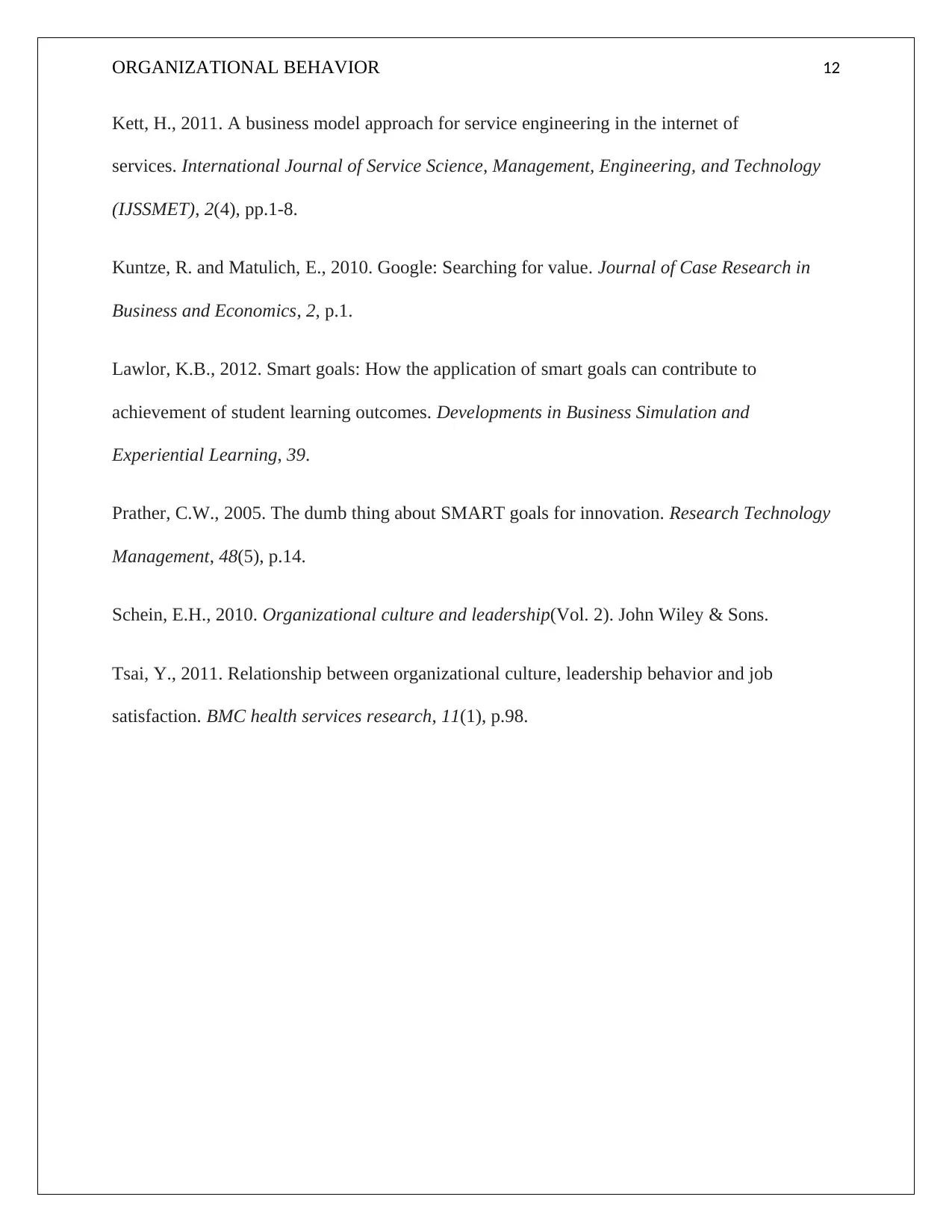
ORGANIZATIONAL BEHAVIOR 12
Kett, H., 2011. A business model approach for service engineering in the internet of
services. International Journal of Service Science, Management, Engineering, and Technology
(IJSSMET), 2(4), pp.1-8.
Kuntze, R. and Matulich, E., 2010. Google: Searching for value. Journal of Case Research in
Business and Economics, 2, p.1.
Lawlor, K.B., 2012. Smart goals: How the application of smart goals can contribute to
achievement of student learning outcomes. Developments in Business Simulation and
Experiential Learning, 39.
Prather, C.W., 2005. The dumb thing about SMART goals for innovation. Research Technology
Management, 48(5), p.14.
Schein, E.H., 2010. Organizational culture and leadership(Vol. 2). John Wiley & Sons.
Tsai, Y., 2011. Relationship between organizational culture, leadership behavior and job
satisfaction. BMC health services research, 11(1), p.98.
Kett, H., 2011. A business model approach for service engineering in the internet of
services. International Journal of Service Science, Management, Engineering, and Technology
(IJSSMET), 2(4), pp.1-8.
Kuntze, R. and Matulich, E., 2010. Google: Searching for value. Journal of Case Research in
Business and Economics, 2, p.1.
Lawlor, K.B., 2012. Smart goals: How the application of smart goals can contribute to
achievement of student learning outcomes. Developments in Business Simulation and
Experiential Learning, 39.
Prather, C.W., 2005. The dumb thing about SMART goals for innovation. Research Technology
Management, 48(5), p.14.
Schein, E.H., 2010. Organizational culture and leadership(Vol. 2). John Wiley & Sons.
Tsai, Y., 2011. Relationship between organizational culture, leadership behavior and job
satisfaction. BMC health services research, 11(1), p.98.
⊘ This is a preview!⊘
Do you want full access?
Subscribe today to unlock all pages.

Trusted by 1+ million students worldwide
1 out of 13
Related Documents
Your All-in-One AI-Powered Toolkit for Academic Success.
+13062052269
info@desklib.com
Available 24*7 on WhatsApp / Email
![[object Object]](/_next/static/media/star-bottom.7253800d.svg)
Unlock your academic potential
Copyright © 2020–2025 A2Z Services. All Rights Reserved. Developed and managed by ZUCOL.





